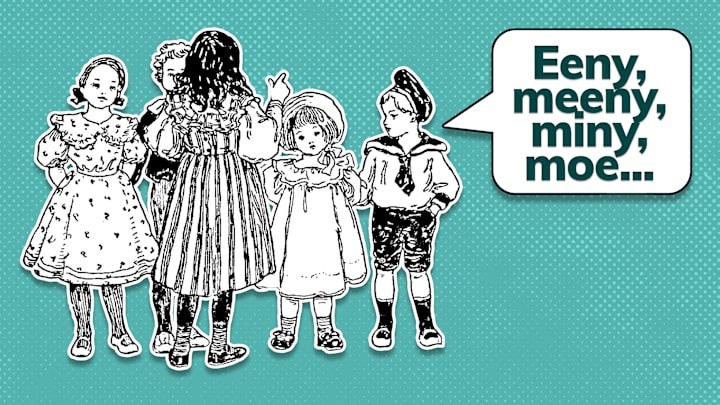A common way for kids to decide who’s the undesirable “it” in a game of tag is to use the counting-out rhyme “eeny, meeny, miny, moe” (sometimes spelled “eenie, meenie, miny, moe”). You’ve probably just completed the verse in your head, but if not, here’s a refresher:
“Eeny, meeny, miny, moe,
Catch a tiger by the toe,
If he hollers, let him go,
Eeny, meeny, miny, moe.”
Though the end result is supposedly random, the speaker can manipulate the outcome—for instance, by adding “you are it” at the end. The use of the rhyme has gone beyond the playground and into pop culture: It’s been used by Homer Simpson to prevent a nuclear meltdown and by The Walking Dead’s Negan to decide who in Rick’s group is going to meet a grisly end.
Different versions of “eeny, meeny, miny, moe” exist around the world, and there seem to be just as many theories about the rhyme’s potential origin—ranging from shepherds counting sheep to priests selecting sacrificial victims.
Catching a Tiger by the Toe
In the English-speaking world, the rhyme can be traced back to at least 1815. In an 1855 edition of the scholarly journal Notes and Queries, someone credited only as “W.” recalled the version of the rhyme they used when choosing who was “it” for tag in New York 40 years earlier:
“Hana, mana, mona, mike;
Barcelona, bona, strike;
Hare, ware, frown, venac;
Harrico, warrico, we, wo, wac!”
Although those words don’t match the ones we chant today, the rhythmic flow is the same; “W.” recalled it after reading a version of the rhyme that had been printed earlier that year, one that is slightly more similar to the modern variation:
“Eeny, meeny, moany, mite,
Butter, lather, boney, strike,
Hair, bit, frost, neck,
Harrico, barrico, we, wo, wack.”
In 1888, chemist Henry Carrington Bolton published a study of counting-out rhymes that included German and Dutch jingles, showing that they contained elements of the rhymes cited in America: “Eena, tena, mona mi, / Pastor, lone, bone, strei” and “Eene, meenen, mukken, / Porceleinen stukken,” respectively. But which version came first is unknown. Bolton’s book is also contains what is almost the modern version rhyme, which had the n-word in place of tiger/tigger and was, according to Bolton, “the favourite among American children to-day.”
The following year, Reverend Walter Gregor presented a collection of rhymes (later published in 1891 [PDF]) to the Buchan Field Club in Scotland; he recorded both the n-word version and one which used neighbour. These two Scottish variants used squeals and quarrels, respectively, instead of hollers.
Over the years, the racial slur version of the rhyme has thankfully fallen out of favor, with replacement words including tinker (a derogatory British term for a beggar), piggy, and—today’s most popular choice—tiger.
The Possible Origins of the Rhyme
As is the case with many nursery rhymes, there are a few dark theories about the origin of “eeny, meeny, miny, moe.” One, as explained by author Robert Hendrickson, is that this counting-out rhyme and others, “are relics of formulas Druid priests used to choose human sacrifices.”

Another sacrificial starting point was proposed by linguists Jan Naarding and Klaas Heeroma, who argue that an older Dutch version of the song, which begins “anne manne miene mukke,” might come from an Old Saxon divination chant. A high priest would supposedly say the words to prompt a sign from the gods that would indicate who should be sacrificed.
Yet another murderous theory is tied to the Cornish version of the rhyme:
“Ena, mena, mona, mite,
Pasca, lara, bona, (or bora), bi,
Elke, belke, boh,
Eggs, butter, cheese, bread,
Stick, stack, stone dead.”
In an 1880 article for The Cornishman newspaper, Thomas Walter Sandrey suggested that these lines originated in ancient Britain and are about withholding food from someone before they are “beaten to death by sticks.”
A less brutal suggestion is that the words are a corruption of Latin. An unnamed writer in an 1884 issue of Overland Monthly theorized that the jingle was originally a “medieval formula in monkish Latin—probably a charm or prayer used in casting lots.” When non-Latin speakers repeated the chant, the words morphed into gibberish.
There are other theories that stem from the words being misheard between languages. One is that British colonizers in India heard the rhyme “ubi eni mana bou, baji neki baji thou, elim tilim latim gou,” which was sung while playing games. Linguist Derek Bickerton believes that the lyrics stem from the Saõ Tomenese phrase ine mina mana mu, which translates to “my sister’s children” in English. Yet another suggestion is that the verse derives from a Swahili poem that was recited by enslaved people and includes the line “iino ya mmiini maiini mo.”
Linguist John McWhorter thinks that the rhyme comes from a Celtic-language counting system, often known as the Anglo-Cymric Score, which was used by shepherds to count their sheep. Different versions that have been recorded include “yan, tan, tethera, methera, pimp” and “aina, peina, para, pedera, pump” (both of which are one to five). These words definitely have the same rhythmic quality as “eeny, meeny, miny, moe,” but the link isn’t certain. There’s also doubt about the shepherds’ score being ancient—the numbers don’t crop up until the 18th century and might actually derive from Welsh—and even about whether they were ever actually used to count sheep (but there is evidence that they were used by knitters!).
“Eeny Meeny Miny Moe” Around the World
Many languages have similar sounding counting-out rhymes that are partly nonsensical. That may just pure coincidence, but in Bolton’s words, it makes “the view of a common origin reasonable.” Although that origin remains uncertain, here are a few examples from around the globe to compare for yourself:
LANGUAGE | RHYME |
|---|---|
French | “Une, mine, mane, mo, |
German | “Ene mene miste, |
Danish | “Ene, mene, ming, mang, |
Dutch | “Iene miene mutte |
Read More Articles About Nursery Rhymes:
